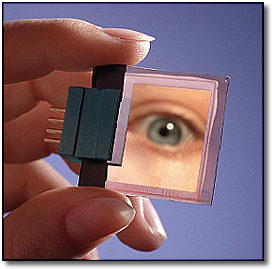
Image: Siemens
 |
Siemens has
their eye on a bright future for organic solar photovoltaic cells
(pictured here). Image: Siemens |
"Organic photovoltaics has the potential of causing a revolution
in the solar industry."
- Andreas Brinkrolf of Siemens Technology Accelerator
| Munich, Germany -
January 15, 2004 [SolarAccess.com] While most solar photovoltaic
(PV) companies are constantly refining and improving silicon cells in
incremental ways, the industry as a whole, and those who support it,
have been waiting years for a technological breakthrough that will drop
the up-front price and mainstream the clean energy technology. Fringe PV
technologies such as organic polymers might be poised on the edge of
major commercial success, say Siemens engineers. Through research with organic photodetectors, Siemens researchers revealed they were recently able to increase the efficiency of printed organic solar photovoltaic (PV) cells from three to over five percent. While this may only be a marginal improvement, organic PV is yet another avenue where solar PV stands to make big strides in lowering the end cost per watt of solar electricity. In contrast to today's silicon cells, organic solar cells can be printed on foils. They are therefore flexible and much lighter in weight, according to Siemens, which handed over its PV activities to Shell Solar in 2001. Another strength of this technology is the very low manufacturing cost. "Our efforts are partly concentrated on replacing non-organic technology", said Christoph Brabec who leads this development. "We mainly aim at new markets that we can open up because of the great benefits of our solar cells." Over 90 percent of solar modules currently in use are made of silicon. Although the solar market experienced continuous growth in recent years, a much wider use of solar technology is restrained by the relatively high cost of silicon-based modules. This explains why researchers worldwide are working on the development of new and low-cost solar technology. Apart from the production cost it is especially the efficiency and service life of a solar cell that are important. Organic PV could prove a promising alternative. Here, solar cells made of special polymers are manufactured in a printing process that enables the production of entirely new solar modules. The photoactive layer of the cell has a thickness of approximately 100 nanometers, which corresponds to about 1/200th of the thickness of a hair. Since the polymers are printed on foil these solar modules are light-weight. Moreover, they are flexible and can be adapted to almost any shape. At Siemens, the development of this technology is part of the research activities in the field of polymer electronics. The object of these activities is to develop novel photodetectors and displays. Another benefit of organic semiconductors is their relatively long service life. Even simple sealing methods do not stop the solar cells from failing in continuous operation at a temperature of 80 degrees Celsius, achieving today a service life of several thousand sun hours, said Siemens. To start with, organic solar cells will first be applied in portable solar modules charging mobile telephones, satellite phones or navigation systems without requiring any connection to a main electrical supply. The first such products are expected to be sold in 2005, said the company. Siemens said that in some time it will be possible to achieve an efficiency of ten percent and a service life of 10,000 sun hours which corresponds to an operating life of approximately ten years. It is therefore conceivable to use organic PV in all main applications of conventional solar systems, said the company. Siemens researchers regard this recent news as a substantial breakthrough in the advances and development of organic PV. The company said that with a reading of over five percent, the efficiency achieved is the highest ever obtained for printed organic solar cells. This high efficiency also makes the technology commercially viable. The Siemens researchers believe that the current technology will even allow an efficiency of about seven percent. Although the Siemens solar division is now under Shell Solar, this particular direction could yield some commercial success. "Our published scientific results are a by-product of our research activities in the field of light sensors," said Guido Weber, Siemens Press Officer Corporate Technology. "In fact we're checking out, whether it could be interesting for a partner to bring our PV results into production." There's also a chance that interesting new PV markets could emerge in areas which could not be sufficiently served with silicon-based technology. Organic photovoltaics could be used for solar windows and solar awnings, for instance. Large surface areas could therefore be used in an entirely new way. In general, this technology can also be used to provide solar power at a considerably lower initial capital expenditure. It also opens up entirely new applications such as providing electricity in remote areas in developing countries or operating large solar farms. "Over and above today's established applications, it will be the cost advantages and the low weight of organic photovoltaics that will open up new applications and new business models for the use of solar power", said Andreas Brinkrolf of Siemens Technology Accelerator, who accompanies the commercialization of this technology. "Organic photovoltaics has the potential of causing a revolution in the solar industry." |
|
|
| For
Further Information: • Siemens Please Note: SolarAccess.com and Arizonaenergy.org do not endorse the sites behind these links. We offer them for your additional research. Following these links will open a new browser window. |